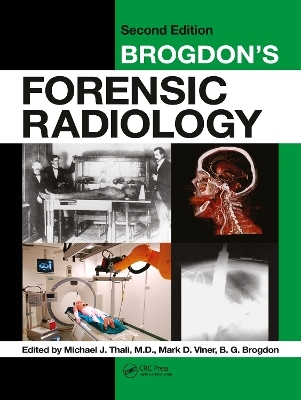
Brogdon's Forensic Radiology
Crc Press Inc (Verlag)
978-1-4200-7562-5 (ISBN)
- Titel z.Zt. nicht lieferbar
- Versandkostenfrei
- Auch auf Rechnung
- Artikel merken
The benchmark first edition of Forensic Radiology, published in 1998, was a milestone in the forensic community — a bestseller throughout the world and a standard reference for practitioners and educators alike. Like its predecessor, Brogdon’s Forensic Radiology, Second Edition covers the entire scope of radiological applications in the forensic sciences, profiling current and anticipated uses of new modalities and techniques.
Features:
Provides an introduction to forensic radiology, including historical perspectives and definitions used in the field
Offers instruction on trial preparation and effective courtroom testimony
Demonstrates the use of forensic radiology in identification of the dead
Explores the use of radiology to help in gunshot and abuse cases and in nonviolent crimes
Contains an entirely new section on virtual imaging and virtopsy
Examines technological and safety issues
For radiologists, forensic scientists, forensic dentists, medical examiners, investigators, and attorneys
Over the past twelve years, the fields of forensic science and radiology have developed considerably, necessitating a revision of this critical work.
New Topics in this Edition include:
The radiologist as an expert witness
Modern cross-sectional imaging in anthropology
New approaches to radiology in mass casualty situations
The use of virtual imaging and virtopsy — new modalities developed and advanced since the publication of the last edition
Forensic and clinical usage of x-rays in body packing for drug smuggling
Imaging in the medical examiner’s facility and in the field
Radiology of special objects, antiquities, and mummies
Michael J. Thali has written many virtual autopsy papers (see www.virtopsy.com) and is editor of the book The Virtopsy Approach. He has been a professor of forensic medicine at the University of Bern, Switzerland since 2006, and at the time of finishing this book is the director of the Forensic Institute at the University of Bern. Mark D. Viner is a Fellow of Cranfield University Forensic Institute, Chief Executive of the Inforce Foundation, and a Senior Manager at St. Bartholomew’s and The Royal London Hospitals. He has a long-held interest in forensic imaging and emergency planning, developed during almost 30 years of experience as radiographer and radiology manager in the United Kingdom. B.G. Brogdon’s interest and experience in forensic radiology goes back more than 40 years to a time when he was radiologist-in- charge at the Division of Diagnostic Radiology at Johns Hopkins. His involvement in the field continued throughout his tenures as professor and Chair of the Departments of Radiology at the University of New Mexico and, later, at the University of South Alabama where he is now University Distinguished Professor Emeritus.
Introduction to Forensic Radiology. Definitions in Forensics and Radiology. Forensic Radiology in Historical Perspective. Scope of Forensic Radiology. Coping with the Courts. The Radiological Expert. The Expert Witness as Viewed from the Bench. The Radiologist in the Courtroom Witness Stand: Good, Bad, and Indifferent. Identification. Identification of the Dead. Radiological Identification: Antropological Parameters.
Modern Cross-Sectional Imaging in Anthropology. Radiographic Applications in Forensic Dental Identification. Virtopsy: Dental Scan and Body CT Imaging as a Screening Tool for Identification. Radiological Identification of Individual Remains. Radiology in Mass Casualty Situations. New Approaches to Radiology in Mass Casualty Situations. Gunshot Wounds.
Forensic Radiology of Gunshot Wounds. New Developments in Gunshot Analysis. Radiology of Abuse. Child Abuse. Abuse of Intimate Partners and of the Elderly: An Overview. Radiology in Nonviolent Crimes. Smuggling/Border Control. Forensic and Clinical Usage of X-rays in Body Packing. Larceny. Radiology of Fakes and Forgery in Art. Virtual Imaging. Reporting and Finding Expert Opinion: Virtopsy and the Logic of Scientific Discovery of K.R. Popper. Photogrammetry-Based Optical Surface Scanning. Cross-Sectional Imaging and Swiss Virtobot Documentation and Analysis: Work Flow and Procedure. Clinical and Forensic Radiology Are not the Same. Postmortem Biopsy. Postmortem Angiography. Using Real 3D Data for Reconstruction. Applications of Rapid-Prototyping Methods in Forensic Medicine. Facial Reconstruction: New Approaches. Virtopsy and Forensic Tissue Simulation and Synthetic Body Models. Facilities, Equipment, and Organization. Organization and Management of Forensic Radiology. Facility, Equipment, and Radiation Protection. Forensic Radiological Technology. Imaging in the Medical Examiner’s Facility. Imaging in the Field. Radiology of Special Objects, Antiquities, and Mummies. Essentials of Diagnostic Imaging. Production of the Radiographic Image. Radiographic Positioning. Index.
| Erscheint lt. Verlag | 10.1.2011 |
|---|---|
| Zusatzinfo | 39 Tables, black and white; 1304 Illustrations, color |
| Verlagsort | Bosa Roca |
| Sprache | englisch |
| Maße | 210 x 280 mm |
| Gewicht | 2064 g |
| Themenwelt | Geisteswissenschaften ► Archäologie |
| Medizinische Fachgebiete ► Radiologie / Bildgebende Verfahren ► Radiologie | |
| Studium ► 2. Studienabschnitt (Klinik) ► Rechtsmedizin | |
| ISBN-10 | 1-4200-7562-4 / 1420075624 |
| ISBN-13 | 978-1-4200-7562-5 / 9781420075625 |
| Zustand | Neuware |
| Haben Sie eine Frage zum Produkt? |
aus dem Bereich


